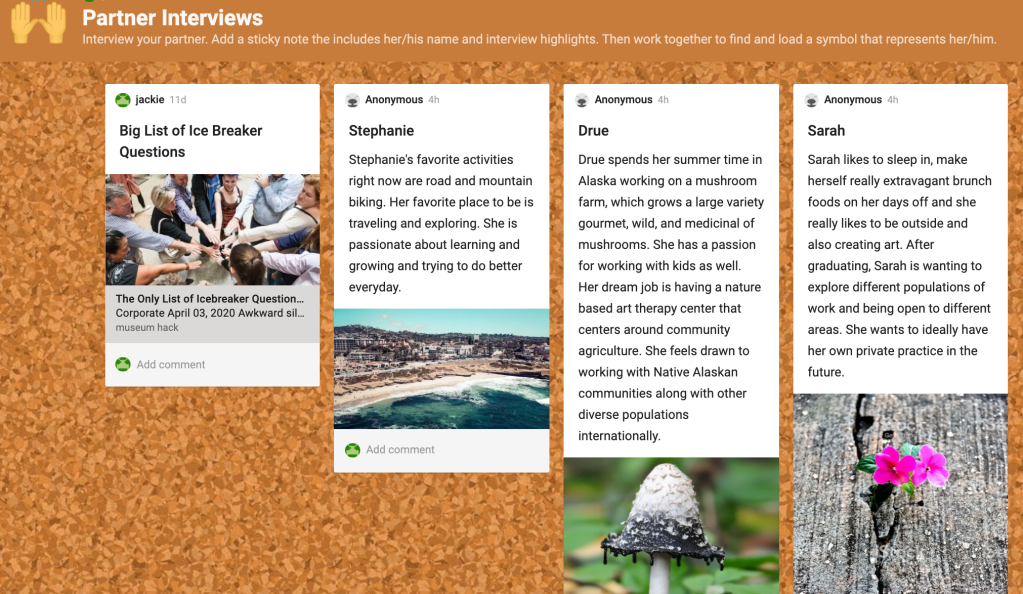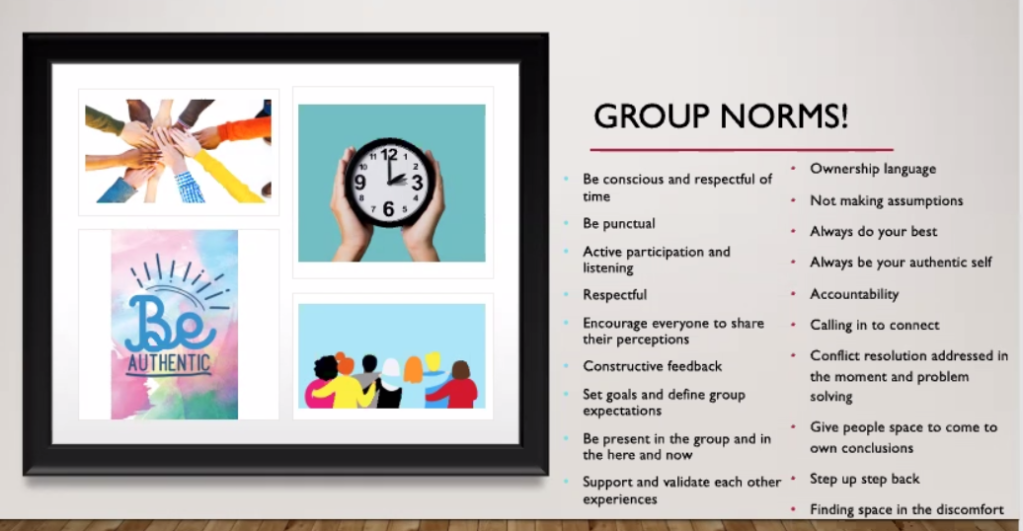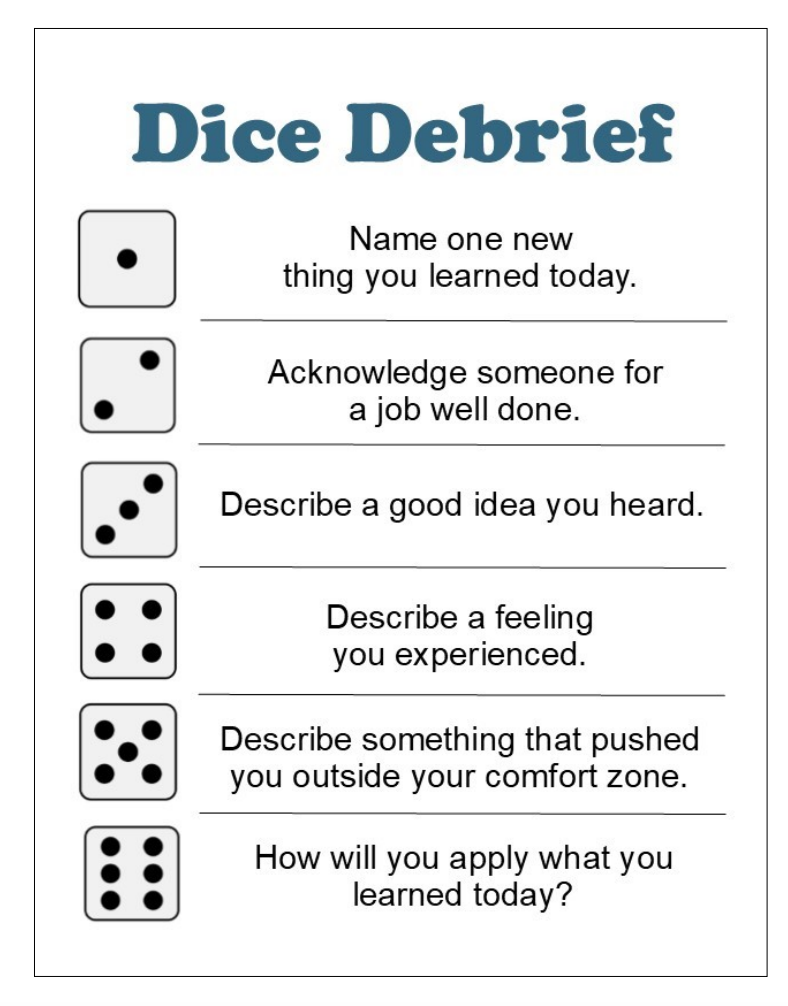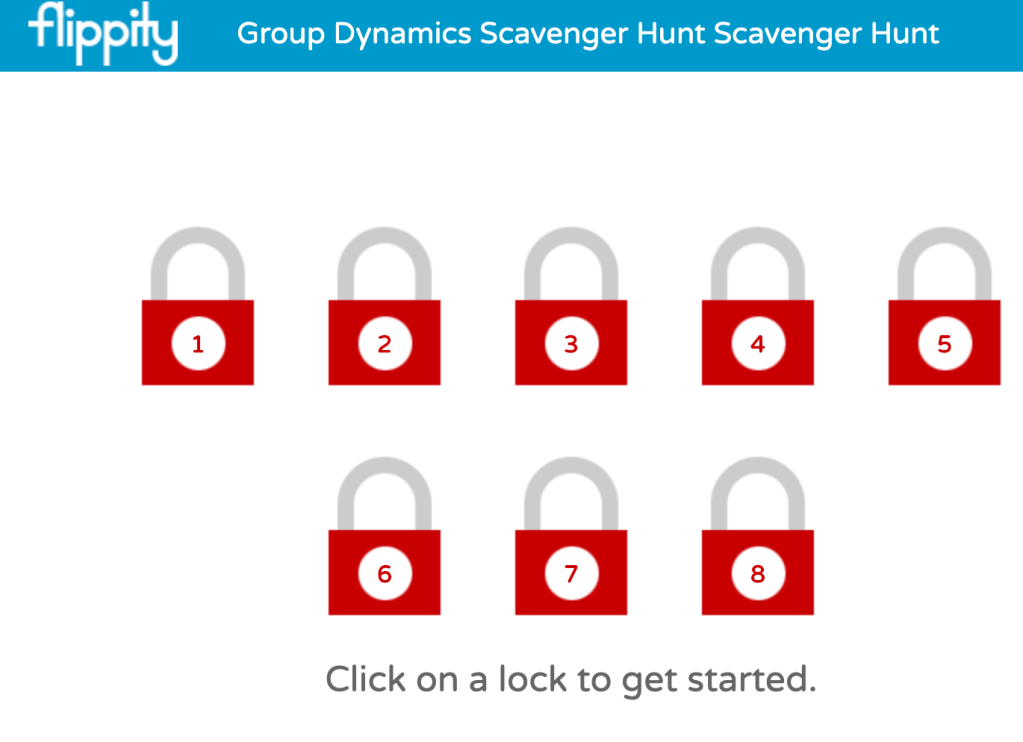Virtual Team Building Activities
I, like many others, was forced to move a face-to-face college class to virtual synchronous meetings in Zoom. This term I am teaching a group dynamics course. One of my goals is to have my students experience similar dynamics and processes as they would face-to-face. Typically, I do this through experiential group activities. My task has become converting these experiences to a virtual environment.
What follows are descriptions of some of these activities:
- Ice Breaker Wheel
- Never Have I Ever
- Two Truths and a Lie Via Flipgrid
- I Am Poems
- Padlet Partner Interviews Partner Interviews
- Team Contracts
- Flippity Scavenger Hunt – Virtual Escape Room
- Body Part Debrief (ala Michelle Cummings)
Ice Breaker Wheel
During the webinar, each student is given a link to the ice breaker wheel. Each student takes turns spinning it to get a question and then provides an answer to the rest of the group.
Never Have I Ever
During the virtual meeting, never have you ever questions are asked. If individual students have experienced it, they jump out of their chairs. There are lots of websites that have these questions including https://icebreakerideas.com/never-have-i-ever/. Here is a list from that website:
Never have I ever . . .:
- Dyed my hair
- Baked a cake from scratch
- Fallen down in public
- Had braces
- Built something out of wood
- Been to Disney World
- Eaten a Krispy Kreme donut
- Screamed during a scary movie
- Been to a professional sporting event
- Rolled down a hill
- Toilet papered someone’s house
- Laughed so hard I cried
- Burned myself with a curling iron
- Gotten seasick
- Eaten food that fell on the floor
- Shared a sucker with my dog
- Had chickenpox
- Shopped at Home Depot
- Spied on my neighbors
- Plucked my eyebrows
- Ridden in a limo
- Had a pet fish
- Lied about my age
- Bought something at a yard sale
- Made a prank call
- Gotten a tattoo
- Had food come out my nose
- Had a massage
- Locked my keys in the car
- Ridden a horse
- Been lost
- Been to Europe
- Built a fire
- Been skydiving
- Played golf
- Had a manicure
- Made mashed
- Made all A’s in school
- Eaten a bug
Two Truths and a Live via Flipgrid
Many have played Two Truths and a Lie. For those who have not or who have forgotten the directions, here they are:
To get started, give out the instructions to the group by letting them know that each person will introduce themselves by stating two truths and one lie. They don’t have to be intimate, life-revealing things, just simple hobbies, interests, or past experiences that make each person unique. The lie can be outrageous, wacky, or sound like a truth, making it even harder for the other participants who have to guess which statement is a lie (https://www.thoughtco.com/2-truths-lie-idea-list-1-31144).
To do this online, each student records her/his two truths and a lie using Flipgrid (The teacher is the only one who needs an account. Here is more information how to use Flipgrid – https://flipgrid.zendesk.com/hc/en-us/articles/360007460474-Getting-Started-Educators). The other class members make their guess for which is the lie via the comment function in Flipgrid. Here is an example:
I Am Poems
Students are provided with an “I Am” template, – https://freeology.com/worksheet-creator/poetry/i-am-poem/. Once the poems are written, participants are given a link to a shared Google Slide presentation (shared with anyone with a link can edit) that you started. They are asked to use one of the presentation slides to compose their poem and include a photo or image that symbolizes the essence of their identity. After all participants complete this task, the presentation, one poem at a time, is shared in the webinar platform. Students read their poems to their classmates when it comes up in the Google Slide presentation.
What follows is an example from my class.
Padlet Partner Interviews
Padlet is used for this activity. (The teacher is the only one who needs an account. For more information about creating Padlets, see https://jn.padlet.com/ ). Students are split into partners (several of the webinar platforms allow for breakout rooms). They interview one another. They can come up with their own questions or they choose some from https://museumhack.com/list-icebreakers-questions/. Once done interviewing, the interviewer puts the summary of her or his interview on a Padlet sticky note and then selects an image (there is a Google search tool within Padlet) that represents the essence of that interview. When the whole group reconvenes, each group member shares one cool thing learned about her or his partner. Below is an example Padlet (screenshot).

Team Contracts
Team contracts are good to use if the group or team will be working together for multiple class sessions over a period of time such as for weeks or months. Groups are given the instruction to come up with norms that will make this a group where individual team or group members feel a sense of safety to disclose information about themselves and also to feel willing to take risks. The class is broken into smaller breakout groups of 3 to 5 people per group. One group member acts as the media specialist. They add norms and graphics based on their small group input and consensus of ideas.
What follows are example team contracts completed during a Zoom session. The following two examples were completed by small groups using technology – the first one with https://www.canva.com/ and the second one with a Powerpoint slide.


The next example was done with one person cutting out letters and adding key terms that her team members brainstormed.

Flippity Scavenger Hunt – Virtual Escape Room
Flippity,net has a template for creating a virtual scavenger hunt/escape room. Here are the directions for how to do so https://flippity.net/ScavengerHunt.htm.
I created one for my group dynamics course if you want to try it out.
(Hint: Some of the answers are open-ended. Some require specific answers. To make it through the entire series of locks, #6 is courage and #7 is active listening.)
Debrief
It is important to put a sense of closure at the end of the virtual group sessions. To do so, a prompt can be given to the students that helps them think and respond about their significant take away from the virtual class session. Each participant is given an opportunity to answer the prompt one at a time in an “around the group” fashion.
What follows are a few developed by Michelle Cummings of Training Wheels. The first is the Dice Debrief. Team members spin a dice and that number role indicates which question they will answer on the following graphic. If someone doesn’t have a dice, they can use a virtual one by just googling “virtual dice.”

The following debrief prompt, developed by Michelle Cummings, is the body part debrief. Each student picks one of the body parts and the corresponding question to answer for their session closing comment.




Leave a comment